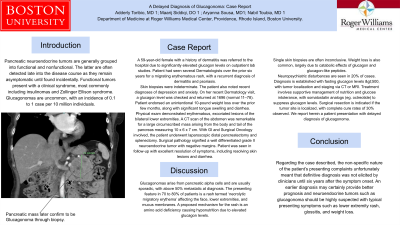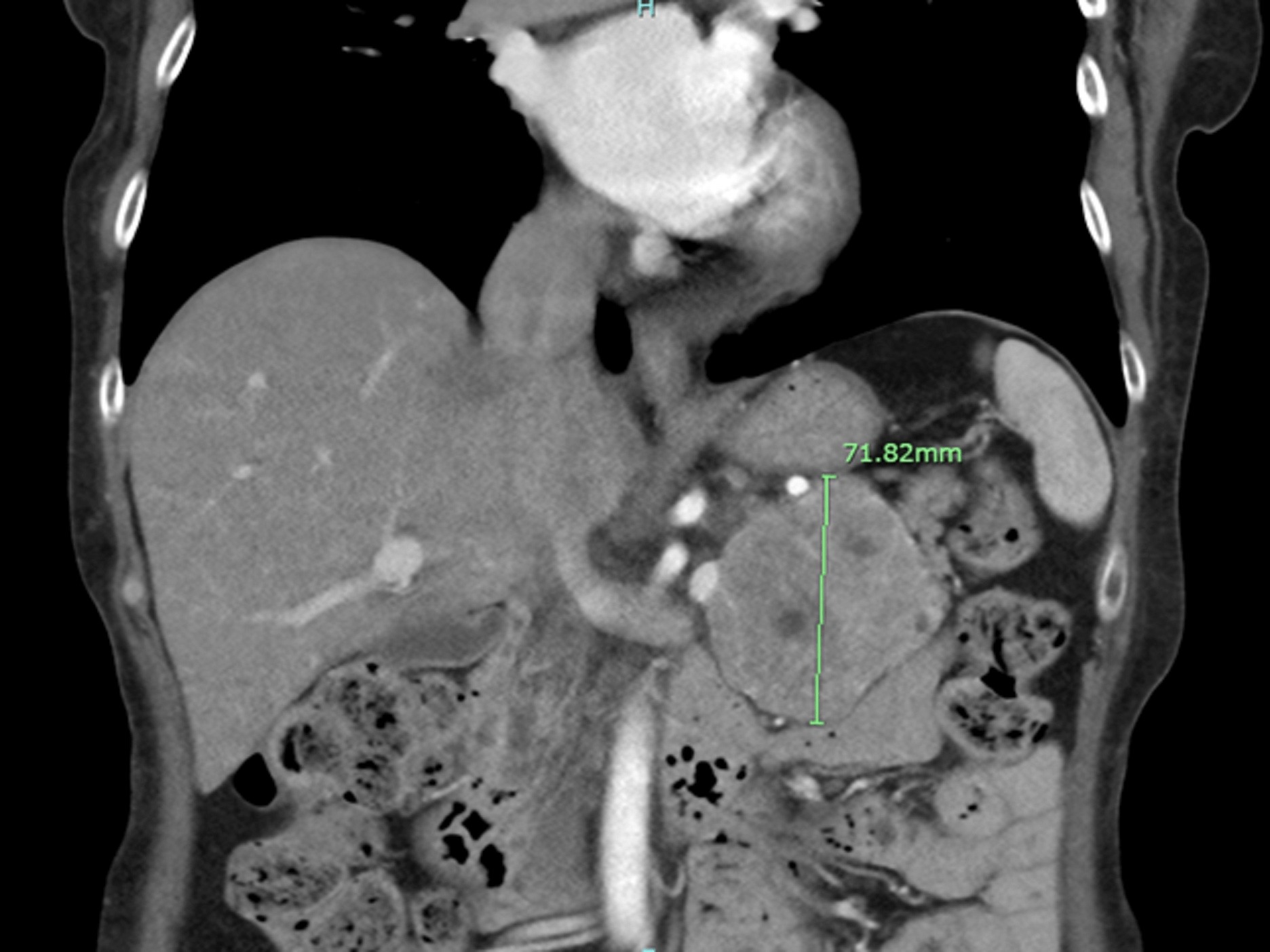Monday Poster Session
Category: Biliary/Pancreas
P1519 - Delayed Diagnosis of Glucagonoma
Monday, October 23, 2023
10:30 AM - 4:15 PM PT
Location: Exhibit Hall

Has Audio
- AT
Adderly Toribio, MD
Roger Willams Medical Center
Boston, MA
Presenting Author(s)
Adderly Toribio, MD1, Maarij Siddiqi, DO2, Aryanna Sousa, MD, MPH2, Nabil Toubia, MD2
1Roger Willams Medical Center, Boston, MA; 2Roger Williams Medical Center, Providence, RI
Introduction: Pancreatic neuroendocrine tumors are grouped into functional and nonfunctional. Nonfuctional remain asymptomatic until found incidentally. Often detected late into the disease course. Functional tumors present as clinical syndromes. Glucagonomas are uncommon, with an incidence of 0.1 to 1 case per 10 million.
It arises from pancreatic alpha cells and are usually sporadic, with above 50% metastatic at diagnosis. A rash termed ‘necrolytic migratory erythema’ is seen in 70 to 80% of patients, affecting the face, lower extremities, and mucus membranes.
We report herein a patient presentation with delayed diagnosis of glucagonoma.
Case Description/Methods: A 59-year-old female with a history of dermatitis referred to the hospital due to significantly elevated glucagon levels on outpatient lab studies. Patient had seen several Dermatologists over the prior 6 years for a migrating rash, with a recurrent diagnosis of dermatitis and psoriasis.
Skin biopsies were indeterminate. The patient also noted recent diagnoses of depression and anxiety. On her recent Dermatology visit, a glucagon level was checked and returned at 1696 (normal 11–78). Patient endorsed an unintentional 10-pound weight loss over few months with significant tongue swelling, and diarrhea. Physical exam demonstrated erythematous, excoriated lesions on bilateral lower extremities.
An abdominal CT scan was remarkable for a large circumscribed mass arising from the body and tail of the pancreas measuring 10x6x7cm. With GI and Surgical Oncology involved, the patient underwent laparoscopic distal pancreatectomy and splenectomy. Surgical pathology signified a well differentiated grade II neuroendocrine tumor with negative margins. Patient was seen in follow-up with excellent resolution of symptoms, including resolving skin lesions and diarrhea.
Discussion: Glucagonomas should be suspected with typical presenting symptoms such as lower extremity rash, glossitis, and weight loss. Often, skin biopsies are inconclusive. Weight loss is common, largely due to hormone induced catabolic state. Neuropsychiatric disturbances are seen in 20% of cases. Diagnosis is established with fasting glucagon levels >500, with tumor localization and staging via CT or MRI. Earlier diagnosis may provide better prognosis.
Treatment involves supportive management and with somatostatin analogs (eg. octreotide) to suppress glucagon levels. Surgical resection is indicated if the tumor site is localized, with complete cure rates of 30% observed.

Disclosures:
Adderly Toribio, MD1, Maarij Siddiqi, DO2, Aryanna Sousa, MD, MPH2, Nabil Toubia, MD2. P1519 - Delayed Diagnosis of Glucagonoma, ACG 2023 Annual Scientific Meeting Abstracts. Vancouver, BC, Canada: American College of Gastroenterology.
1Roger Willams Medical Center, Boston, MA; 2Roger Williams Medical Center, Providence, RI
Introduction: Pancreatic neuroendocrine tumors are grouped into functional and nonfunctional. Nonfuctional remain asymptomatic until found incidentally. Often detected late into the disease course. Functional tumors present as clinical syndromes. Glucagonomas are uncommon, with an incidence of 0.1 to 1 case per 10 million.
It arises from pancreatic alpha cells and are usually sporadic, with above 50% metastatic at diagnosis. A rash termed ‘necrolytic migratory erythema’ is seen in 70 to 80% of patients, affecting the face, lower extremities, and mucus membranes.
We report herein a patient presentation with delayed diagnosis of glucagonoma.
Case Description/Methods: A 59-year-old female with a history of dermatitis referred to the hospital due to significantly elevated glucagon levels on outpatient lab studies. Patient had seen several Dermatologists over the prior 6 years for a migrating rash, with a recurrent diagnosis of dermatitis and psoriasis.
Skin biopsies were indeterminate. The patient also noted recent diagnoses of depression and anxiety. On her recent Dermatology visit, a glucagon level was checked and returned at 1696 (normal 11–78). Patient endorsed an unintentional 10-pound weight loss over few months with significant tongue swelling, and diarrhea. Physical exam demonstrated erythematous, excoriated lesions on bilateral lower extremities.
An abdominal CT scan was remarkable for a large circumscribed mass arising from the body and tail of the pancreas measuring 10x6x7cm. With GI and Surgical Oncology involved, the patient underwent laparoscopic distal pancreatectomy and splenectomy. Surgical pathology signified a well differentiated grade II neuroendocrine tumor with negative margins. Patient was seen in follow-up with excellent resolution of symptoms, including resolving skin lesions and diarrhea.
Discussion: Glucagonomas should be suspected with typical presenting symptoms such as lower extremity rash, glossitis, and weight loss. Often, skin biopsies are inconclusive. Weight loss is common, largely due to hormone induced catabolic state. Neuropsychiatric disturbances are seen in 20% of cases. Diagnosis is established with fasting glucagon levels >500, with tumor localization and staging via CT or MRI. Earlier diagnosis may provide better prognosis.
Treatment involves supportive management and with somatostatin analogs (eg. octreotide) to suppress glucagon levels. Surgical resection is indicated if the tumor site is localized, with complete cure rates of 30% observed.

Figure: Body and pancreatic tail mass
Disclosures:
Adderly Toribio indicated no relevant financial relationships.
Maarij Siddiqi indicated no relevant financial relationships.
Aryanna Sousa indicated no relevant financial relationships.
Nabil Toubia indicated no relevant financial relationships.
Adderly Toribio, MD1, Maarij Siddiqi, DO2, Aryanna Sousa, MD, MPH2, Nabil Toubia, MD2. P1519 - Delayed Diagnosis of Glucagonoma, ACG 2023 Annual Scientific Meeting Abstracts. Vancouver, BC, Canada: American College of Gastroenterology.
